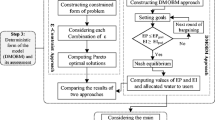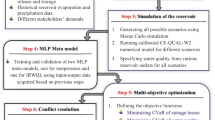Abstract
This paper develops a multi-objective conflict resolution simulation-optimization model based on a leader-follower game to resolve conflicts between different water users while optimizing water quality in the river through selective depth water withdrawal from the reservoir. Iran Water Resources Management Company (IWRMC), given the nature of the power distribution in this region, is selected as leader, and agricultural, domestic, and industrial water users are selected as followers. Nash-Harsanyi bargaining theory is used as a nested model in this general framework to model competition between followers. The proposed selective withdrawal approach considers four reservoir outlets, located at 120, 145, 163, and 181 m above sea level. Water withdrawal from multiple outlets addresses reservoir thermal stratification and water quality. Temperature and water quality are simulated based on different possible scenarios of reservoir inflow and release using a calibrated CE-QUAL-W2 model. Five artificial neural network (ANN) surrogate/meta models are then trained and validated based on CE-QUAL-W2 model results for each water quality variable. Subsequently, these validated surrogate models are coupled with the NSGA-II optimization model, which along with the utility functions of different stakeholders, constitute the building blocks of our conflict resolution multi-objective optimization model. Finally, three decision-making methods, namely AHP, PROMETHEE, and TOPSIS, are utilized to choose the superior compromise solution. Our results show that water withdrawal from multiple reservoir outlets ensures optimal water allocation to different stakeholders while satisfying the desired water quality criteria. In this study, the top outlet (181 m) has desirable quality, and the IRWQISC water quality criterion at the top and deepest outlets are highest and lowest, respectively.















Similar content being viewed by others
References
Alizadeh MR, Nikoo MR, Rakhshandehroo GR (2017a) Hydro-environmental management of groundwater resources: a fuzzy-based multi-objective compromise approach. J Hydrol 551:540–554
Alizadeh MR, Nikoo MR, Rakhshandehroo GR (2017b) Developing a multi-objective conflict-resolution model for optimal groundwater management based on fallback bargaining models and social choice rules: a case study. Water Resour Manag 3:11457–11472
Alizadeh MR, Nikoo MR (2018) A fusion-based methodology for meteorological drought estimation using remote sensing data. Remote Sens Environ 211:299–247
Bahaduri U, Manna E, Barbier J, Liebe (2009) Cooperation in transboundary water sharing under climate change. SSRN Electronic Journal https://doi.org/10.2139/ssrn.1420651
Çalışkan A, Elçi Ş (2009) Effects of selective withdrawal on hydrodynamics of a stratified reservoir. Water Resour Manag 23(7):1257–1273
Casamitjana X, Serra T, Colomer J, Baserba C, Perez-Losada J (2003) Effects of the water withdrawal in the stratification patterns of a reservoir. Reserv Limnol Water Qual 504(1-3):21–28
Castelletti A, Yajima H, Giuliani M, Soncini-Sessa R, Webe E (2014) Planning the optimal operation of a multi-outlet water reservoir with water quality and quantity targets. J Water Resour Plan Manag 140(4):496–510. https://doi.org/10.1061/(ASCE)WR.1943-5452.0000348
Chen Y, Lu H, Li J, Ren L, He H (2017) A leader-follower-interactive method for regional water resources management with considering multiple water demands and eco-environmental constraints. J Hydrol 548:121–134
Cole TM, Wells SA (2015) CE-QUAL-W2: a two dimensional, laterally averaged, hydrodynamic and water quality model, version 3.72. Instruction Rep. EL-2002-1, U.S. Army Engineering and Research Development Center, Vicksburg, Miss.
Deb K, Agrawal S, Pratap A, Meyarivan T (2000) A fast elitist non-dominated sorting genetic algorithm for multi-objective optimization: NSGA-II. International Conference on Parallel Problem Solving from Nature Springer, Berlin Heidelberg 1917:849–858
Deb K, Pratap A, Agarwal S, Meyarivan TAMT (2002) A fast and elitist multi objective genetic algorithm: NSGA-II. IEEE Trans Evol Comput 6(2):182–197
Elçi, Ş (2008) Effects of thermal stratification and mixing on reservoir water quality. Limnology 9(2):135–142
Gelda R, Effler S (2007) Simulation of operations and water quality performance of reservoir multilevel intake configurations. J Water Resour Plan Manag 133(1):78–86
Ghodsi SH, Kerachian R, Malakpour Estalaki S, Nikoo MR, Zahmatkesh Z (2016) Developing a stochastic conflict resolution model for urban runoff quality management: application of info-gap and bargaining theories. J Hydrol 533:200–212
Hashempour Bakhtiari P, Nikoo MR, Izady A, Talebbeydokhti N (2020) A coupled agent-based risk-based optimization model for integrated urban water management. Sustain Cities Soc 53:101922
Kerachian R, Karamouz M (2007) A stochastic conflict resolution model for water quality management in reservoir river systems. Water Resour Res 30:866–882
Khorshidi S, Nikoo MR, Ebrahimi E, Sadegh M (2019a) A robust decision support leader-follower framework for design of contamination warning system in water distribution network. J Clean Prod 214:666–673
Khorshidi MS, Nikoo MR, Sadegh M, Nematollahi B (2019b) A multi-objective risk-based game theoretic approacto reservoir operation policy in potential future drought condition. Water Resour Manag 1–16
Madani K (2010) Game theory and water resources. J Hydrol 381(3):225–238
Mallakpour I, Sadegh M, AghaKouchak A (2018) A new normal for streamflow in California in a warming climate: wetter wet seasons and drier dry seasons. J Hydrol 567:203–211
Mallakpour I, AghaKouchak A, Sadegh M (2019) Climate-induced changes in the risk of hydrological failure of major dams in California. Geophys Res Lett 46(4):2130–2139
Masoumi F, Afshar A, Palatkaleh ST (2016) Selective withdrawal optimization in river–reservoir systems; trade-offs between maximum allowable receiving waste load and water quality criteria enhancement. Environ Monit Assess 188(7):390
Maymandi N, Kerachian R, Nikoo MR (2018) Optimal spatio-temporal design of water quality monitoring networks for reservoirs: application of the concept of value of information. J Hydrol 558:328–340
Mehrparvar M, Ahmadi A, Safavi HR (2016) Social resolution of conflicts over water resources allocation in a river basin using cooperative game theory approaches: a case study. Int J River Basin Manag 14(1):33–45
Monghasemi S, Nikoo MR, Khaksar Fasaee MH, Adamowski J (2017) A Hybrid of genetic algorithm and evidential reasoning for optimal design of project scheduling: a systematic negotiation framework for multiple decision-makers. Int J Inf Technol Decis Mak 16(2):389–420
Naserizade SS, Nikoo MR, Montaseri H (2018) A risk-based multi-objective model for optimal placement of sensors in water distribution system. J Hydrol 557:147–159
Nikoo MR, Varjavand I, Kerachian R, Pirooz MD, Karimi A (2014) Multi objective optimum: a design of double-layer perforated-wall breakwaters: application of NSGA-II and bargaining models. Appl Ocean Res 47:47–52
Nikoo MR, Khorramshokouh N, Monghasemi S (2015) Optimal design of detention rock fill dams using a simulation-based optimization approach with mixed sediment in the flow. Water Resour Manag 29(15):5469–5488
Nikoo MR, Pourshahabi S, Rezazadeh N, Shafiee ME (2017) Stakeholder engagement in multi-objective optimization of water quality monitoring network, case study: Karkheh dam reservoir. Water Sci Technol 18(3):966–974
Niksokhan MH, Kerachian R, Karamouz M (2009) A game theoretic approach for trading discharge permits in rivers. Water Sci Technol 60(3):793–804
Olden JD, Naiman RJ (2010) Incorporating thermal regimes in to environmental flows assessments: modifying dam operations to restore freshwater ecosystem integrity. Freshwater Bio 55(1):86–107
Raei E, Nikoo MR, Pourshahabi S (2017) A Multi-objective simulation optimization model for in-situ bioremediation of groundwater contamination: application of bargaining theory. J Hydrol 551:407–422
Rheinheimer DE, Null SE, Lund JR (2015) Optimizing selective withdrawal from reservoir to manage downstream temperature with climate warming. J Water Resour Plan Manag 141(4):04014063. https://doi.org/10.1061/(ASCE)WR.1943-5452.0000447
Saadatpour M, Afshar A, Edinger JE (2017) Surrogate-model assisted 2D hydrodynamic and thermal simulation model (CE-QUAL-W2) in deriving optimal reservoir operational strategy in selective withdrawal scheme. Water Resour Manag 31(9):2729–2744
Sadegh M, Mahjouri N, Kerachian R (2010) Optimal inter-basin water allocation using crisp and fuzzy Shapley games. Water Resour Manag 24(10):2291–2310
Sadegh M, Kerachian R (2011) Water resources allocation using solution concepts of fuzzy cooperative games: fuzzy least core and fuzzy weak least core. Water Resour Manag 25(10):2543–2573
Sadegh M, Vrugt JA (2013) Bridging the gap between GLUE and formal statistical approaches: approximate Bayesian computation. Hydrol Earth Syst Sci 17(12):4831–4850
Sadegh M, Ragno E, Agha Kouchak A (2017) Multivariate copula analysis toolbox (MvCAT): describing dependence and underlying uncertainty using a Bayesian framework. Water Resour Res 53(6):5166–5183
Sadegh M, Hernandez J, MMS, Haghighi AT (2018) The quest for hydrological signatures: effects of data transformation on Bayesian inference of watershed models. Water Resour Manag 32(5):1867-1881
Safari N, Zarghami M, Szidarovszky F (2014) Nash bargaining and leader–follower models in water allocation: application to the Zarrinehrud River basin, Iran. Appl Math Model 38:1959–1968
Sechi GM, Zucca R (2015) Water resources allocation in critical scarcity conditions: a bankruptcy game approach. Water Resour Manag 29:541–555
Shirangi E, Kerachian R, Shafai Bajestan M (2008) A simplified model for reservoir operation considering the water quality issues: application of the Young conflict resolution theory. Environ Monit Assess 146:77–89
Soleimani S, Bozorg-Hadad O, Saadatpour M, Hugo AL (2016) Optimal selective withdrawal rules using a coupled data mining model and genetic algorithm. J Water Resour Plan Manag 142(12):04016064. https://doi.org/10.1061/(ASCE)WR.1943-5452.0000717
Soltani F, Kerachian R, Shirangi E (2010) Developing operating rules for reservoirs considering the water quality issues: application of ANFIS-based surrogate models. Expert Syst Appl 37:6639–6645
Stackelberg HV (1934) Markt Form und Gleichgewicht. Springer, Berlin
Taravatrooy N, Nikoo MR, Sadegh M, Parvinnia M (2018) A hybrid clustering-fusion methodology for land subsidence estimation. Nat Hazards 94(2):905–926
Tavakoli A, Kerachian R, Nikoo MR, Soltani M, Malakpour Estalaki S (2014) Water and waste load allocation in rivers with emphasis on agricultural return flows: application of fractional factorial analysis. Environ Monit Assess 186 (9):5935–5949
Zheng T, Sun S, Liu H, Xia Q, Zong Q (2017) Optimal control of reservoir release temperature through selective withdrawal intake at hydropower dam. Water Sci Technol 18(3):279–299
Author information
Authors and Affiliations
Corresponding author
Ethics declarations
Conflict of interest
The authors declare that they have no conflict of interest
Additional information
Responsible editor: Xianliang Yi
Publisher’s note
Springer Nature remains neutral with regard to jurisdictional claims in published maps and institutional affiliations.
Electronic supplementary material
ESM 1
(DOCX 473 kb)
Rights and permissions
About this article
Cite this article
Haghighat, M., Nikoo, M.R., Parvinnia, M. et al. Multi-objective conflict resolution optimization model for reservoir’s selective depth water withdrawal considering water quality. Environ Sci Pollut Res 28, 3035–3050 (2021). https://doi.org/10.1007/s11356-020-10475-y
Received:
Accepted:
Published:
Issue Date:
DOI: https://doi.org/10.1007/s11356-020-10475-y




